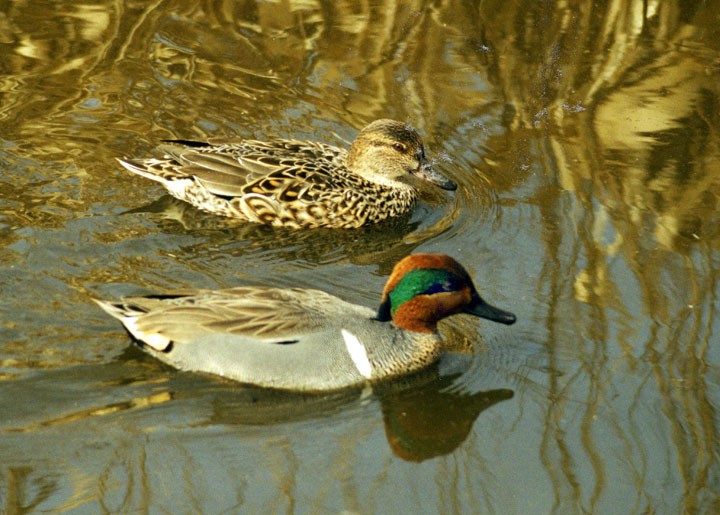Green-winged Teal
A species of Anas Scientific name : Anas carolinensis Genus : Anas
Green-winged Teal, A species of Anas
Botanical name: Anas carolinensis
Genus: Anas
Content
Description People often ask General Info
Description
The green-winged teal (Anas carolinensis or Anas crecca carolinensis) is a common and widespread duck that breeds in the northern areas of North America except on the Aleutian Islands. It was considered conspecific with the Eurasian teal (A. crecca) for some time but the issue is still being reviewed by the American Ornithological Society; based on this the IUCN and BirdLife International do not accept it as a separate species at present. However, nearly all other authorities consider it distinct based on behavioral, morphological, and molecular evidence. The scientific name is from Latin Anas, "duck" and carolinensis, "of Carolina". This dabbling duck is strongly migratory and winters far south of its breeding range. It is highly gregarious outside of the breeding season and will form large flocks. In flight, the fast, twisting flocks resemble waders. This is the smallest North American dabbling duck. The breeding male has grey flanks and back, with a yellow rear end and a white-edged green speculum, obvious in flight or at rest. It has a chestnut head with a green eye patch. It is distinguished from drake common teals (the Eurasian relative of this bird) by a vertical white stripe on side of breast, the lack of both a horizontal white scapular stripe and the lack of thin buff lines on its head. The females are light brown, with plumage much like a female mallard. They can be distinguished from most ducks on size, shape, and the speculum. Separation from female common teal is problematic. In non-breeding (eclipse) plumage, the drake looks more like the female. It is a common duck of sheltered wetlands, such as taiga bogs, and usually feeds by dabbling for plant food or grazing. It nests on the ground, near water and under cover. While its conservation status is not evaluated by IUCN at present due to non-recognition of the taxon, it is plentiful enough to make it a species of Least Concern if it were; it is far more plentiful than the common teal. It can be seen in vast numbers in the Marismas Nacionales-San Blas mangroves of western Mexico, a main wintering area. This is a noisy species. The male has a clear whistle, whereas the female has a feeble quack.
Size
38 cm
Life Expectancy
20-27 years
Nest Placement
Ground
Feeding Habits
Green-winged Teal predominantly feast on seeds from sedges, grasses, and aquatic plants, also consuming grains like corn to small invertebrates. Green-winged Teal's feeding involves dabbling in shallow water. Their dietary adaptability includes varied forage from vegetative matter to insects, revealing a wide-ranging diet.
Habitat
Wetlands of the Canadian parkland, northern boreal forest associations, mixed-prairie associations than in shortgrass associations, arctic tundra, semidesert communities, grasses, sedge meadows, dry hillsides having brush or aspen cover, most often beds of rushes, in western Montana most under greasewood 
Dite type
Omnivorous
People often ask
General Info
Feeding Habits
Bird food type
Sounds
Call
Recording location: United States
Call
Recording location: United States
Distribution Area
All three green-winged teal subspecies occur in the northern hemisphere during summer and in winter extend to northern South America, central Africa, southern India, Burma, and the Philippines. In North America, ssp. carolinensis occurs across the continent and is joined in the Aleutian Islands by ssp. nimia, which remains there throughout the year. Anas crecca breeds in Iceland, Europe, and Asia. It is also seen occasionally during the winter in North America along the Atlantic Coast. The American green-winged teal breeds from the Aleutian Islands, northern Alaska, Mackenzie River delta, northern Saskatchewan, Manitoba, Ontario, Quebec, and Labrador south to central California, central Nebraska, central Kansas, southern Minnesota, Wisconsin, Ontario, Quebec, Newfoundland, and the Maritime Provinces. The American green-winged teal winters from southern Alaska and southern British Columbia east to New Brunswick and Nova Scotia and south to Central America. It also winters in Hawaii. There is a single photographic record from South America. 
